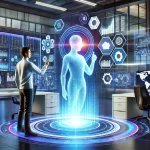
From Lens to Logic Gates: The Journey from Traditional Biology to Computational Bioinformatics
August 24, 2023From Glass Slides to Silicon Chips: Tracing the Path from Observational Biology to Data-Driven Bioinformatics
The Dawn of Up-Close Examination: Classic Biology
In the beginning, biology was all about looking closely at things. Microscopes were the go-to gadget for checking out everything from tiny organisms to cells and tissues. This hands-on, eyes-on approach gave us the basics, like how to classify species and understand how traits get passed down.
Math Enters the Scene: Early Computational Whispers
Even back in the day, biology had a number-crunching side. Fields like population genetics and the study of ecosystems started using math to make sense of things. But most biologists considered this maths stuff more of a side gig than the main show.
The Big Shake-Up: Molecular Biology Comes Alive
Fast forward to the mid-20th century, and boom! Molecular biology bursts onto the scene. The discovery of DNA’s double helix in 1953 was a game-changer. Suddenly, biology wasn’t just about looking at life but also understanding its very code.
The Milestone of Milestones: The Human Genome Project
In 1990, the Human Genome Project kicked off, and it was huge. This wasn’t just a biology project; it needed some serious computer power. Biologists and computer geeks teamed up, and just like that, bioinformatics was born.
Bioinformatics Takes Its First Steps
After the human genome project, a large amount of data is emerged. Managing all this information required a special set of skills—a mix of biology, computer science, and good old number-crunching. And so, bioinformatics became its own thing.
Getting Tooled Up: Bioinformatics Finds Its Groove
In the early days, bioinformatics was pretty basic. We had simple databases and tools like BLAST for lining up sequences. But as time went on, things got fancier. We started using Hidden Markov Models, machine learning, and all sorts of specialized databases.
The Here and Now: A Mash-Up of Disciplines
In the current scenario, bioinformatics has merged different fields like computer science, math, and the integration of machine learning and data science. And it’s not stopping there. Next up? Think AI and quantum computing.
Bioinformatics didn’t emerge suddenly, it is the result of rapid progress and the merger of computer science and biology fields. It’s like a perfect marriage between the hands-on, experimental vibe of old-school biology and the problem-solving, data-loving spirit of computer science.


















